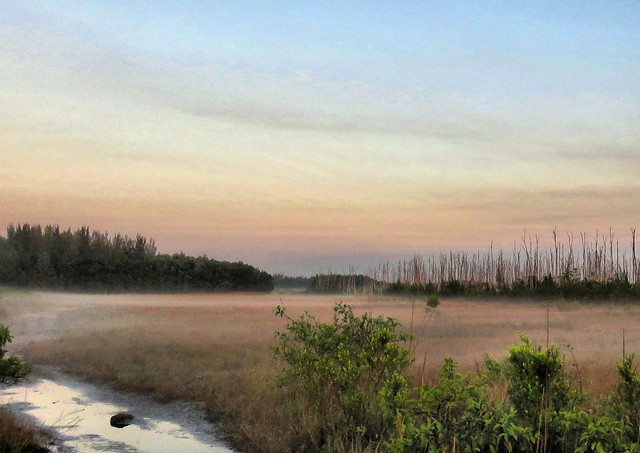
Before we departed Florida for our second home in Illinois, we were pleased to see receding water levels in our local wetlands. High water dilutes the prey upon which both sight feeders (such as herons and egrets) and tactile feeders (storks and ibises) depend. There have been widespread nesting failures of these species this season, as they do not breed if food is scarce.
Conversely, low water also discourages breeding because the birds benefit if their nest trees are in standing water. This deters terrestrial predators and encourages alligators which not only protect the nests but are rewarded when young birds fall into the water. Optimal breeding time usually begins around November and finishes before spring rains once again flood the wetlands.
An old cypress stump, which I call the "Enchanted Island," provides a convenient gauge of the depth of the water near the shore of the lake in our birding patch. By late winter it normally would be sitting on a mud flat.
In March, 2015 the water level was a bit above average because of late winter rains:
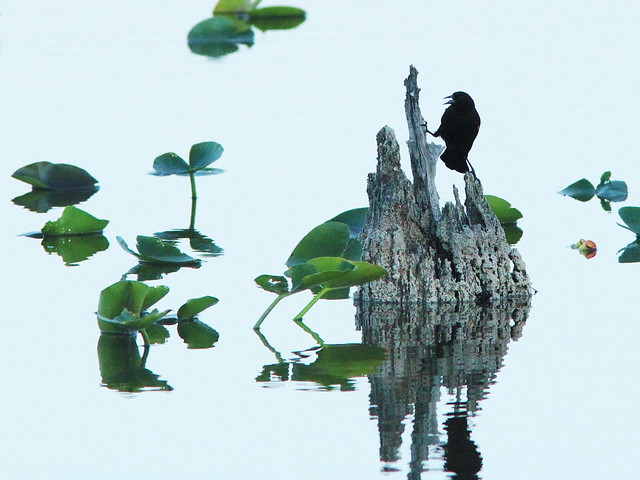
An unusually dry summer followed, and it was high and dry by July, 2015:
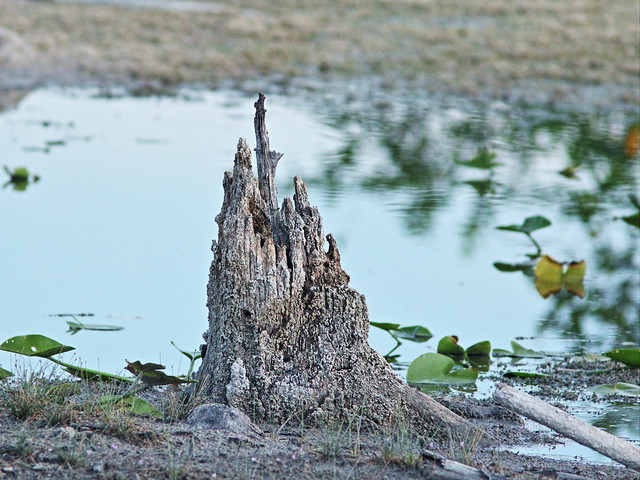
Then the record-setting winter rains came, and by December, 2015, only the top of its spire appeared above about 3 feet of water:
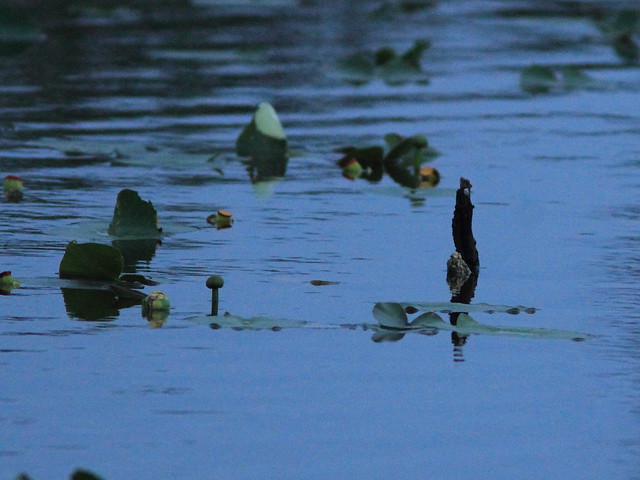
Here it was on April 12, 2016:
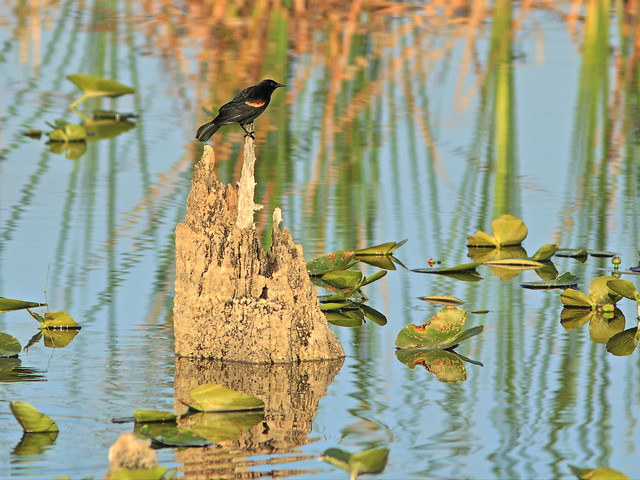
The newly created shallows now have attracted waders, including several Black-necked Stilts:
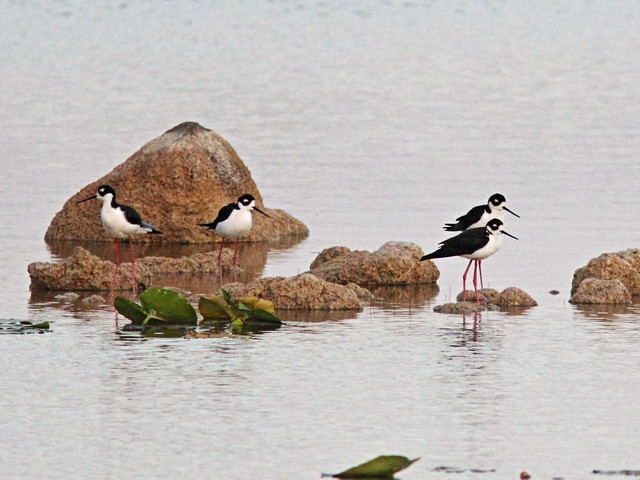
One arrived early on April 12. I first saw it during the "blue hour" before sunrise. My photo was very dark, so I nudged it to life by overlaying a series of lighter exposures from the original RAW image::
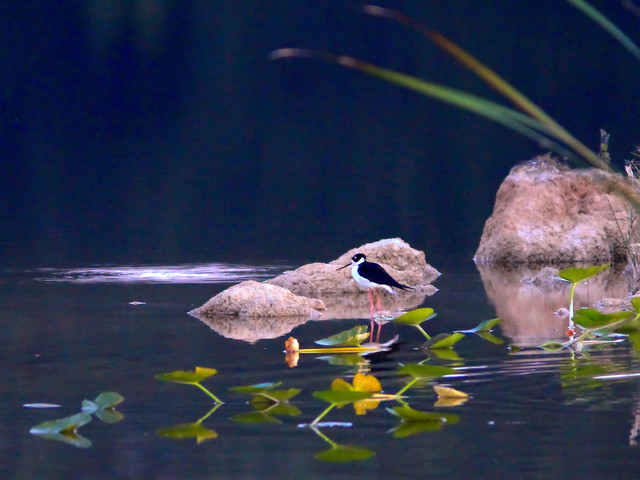
A bit later, while the sun was still low, a flock of five stilts foraged in the shallows:
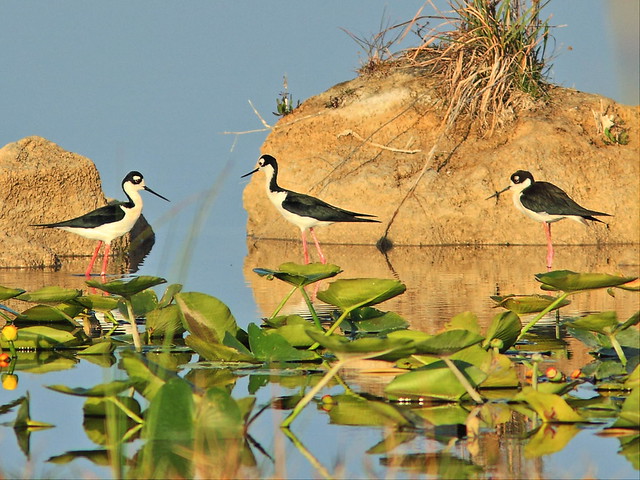
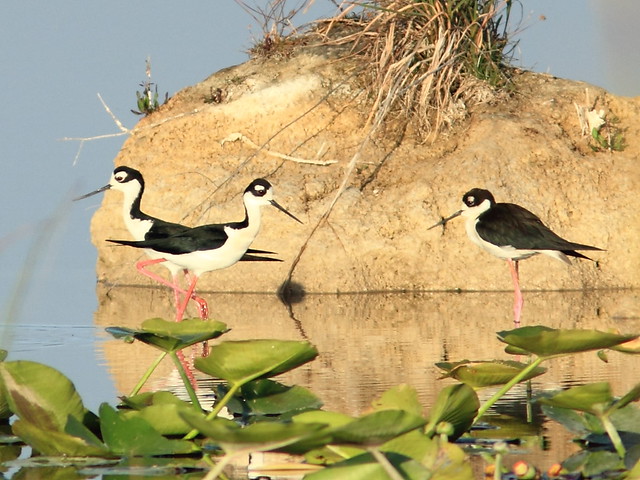
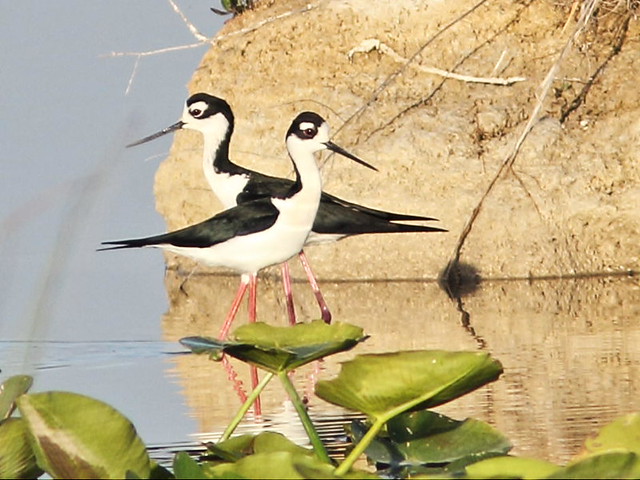
The eggs in a Green Heron nest, which I had been observing for about two weeks, began hatching during my last couple of days in Florida. At first (on April 13) I saw four chicks and one unhatched egg. In this photo the parent is feeding them regurgitated fish particles. The egg is a beautiful blue color:
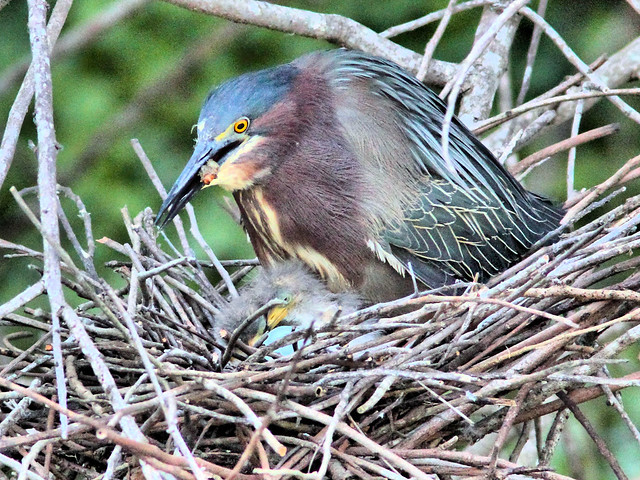
The next day I counted five hatchlings:
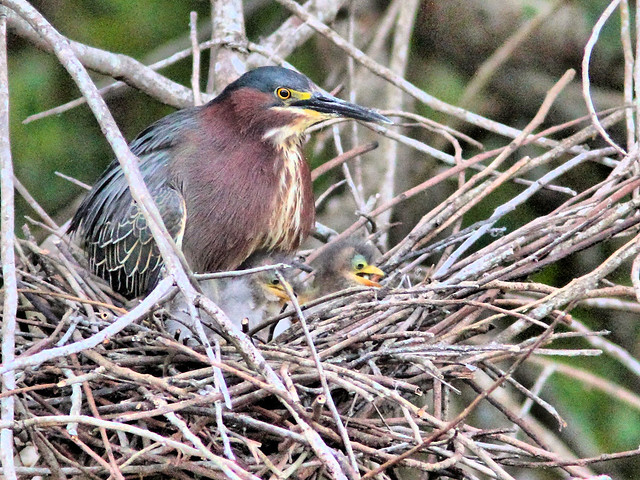
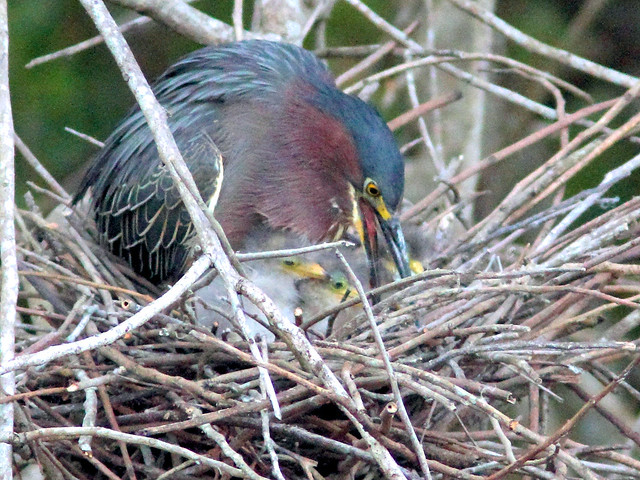
The nest is in plain sight over the water of a canal in the bare branches of an herbicide-treated tree and is exposed to the elements and predators. About 6 feet away and deeper amid the dead branches, a second pair was tending a nest still containing eggs. I am anxious about their safety.
Migrating warblers, including this acrobatic Black-and-White Warbler, started arriving just before our departure:
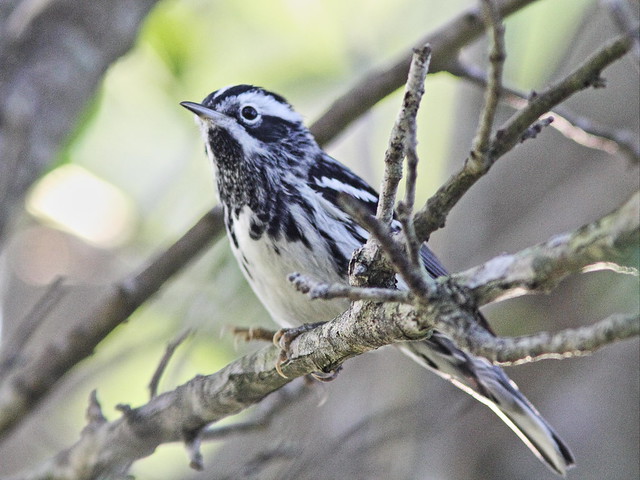

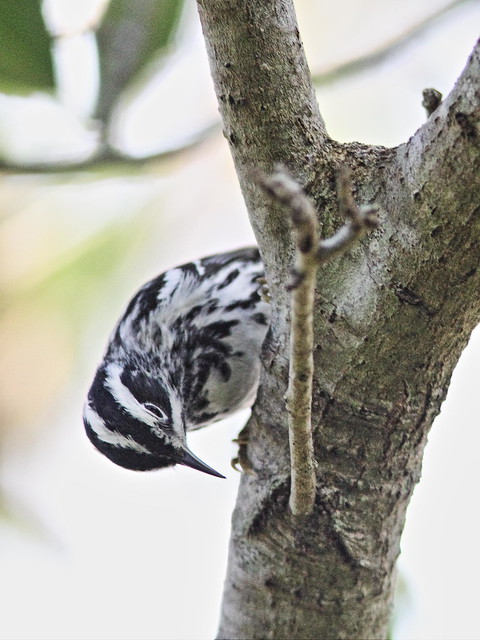
Other notable sightings provided nice "parting shots," including a Tricolored Heron in dawn's glow

The first Caspian Tern of the season flew over the lake:
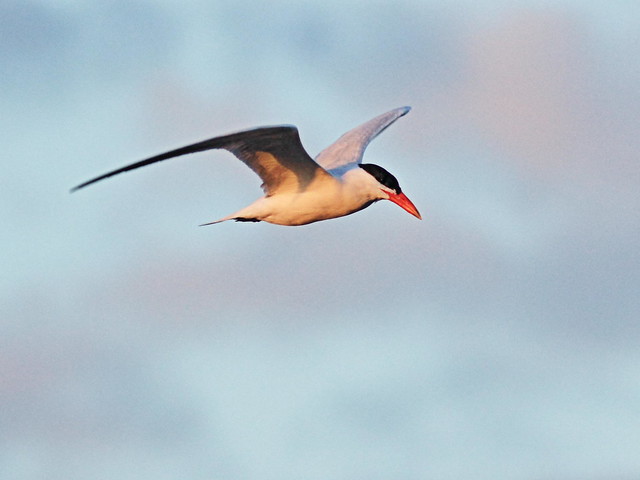
Least Terns also appeared on the lake, a sure sign that spring had arrived:
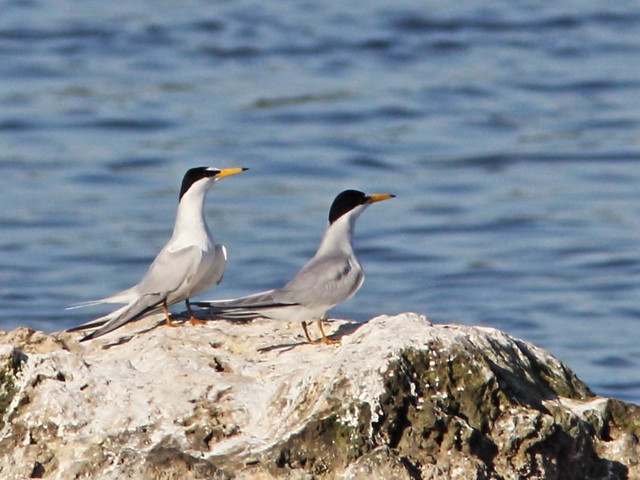
A flock of migrating Blue-winged Teal flew along the opposite shore (click on photo for enlarged view):
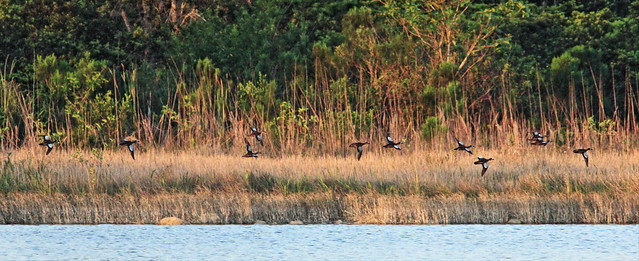
A pair of Mottled Ducks exercised their wings:
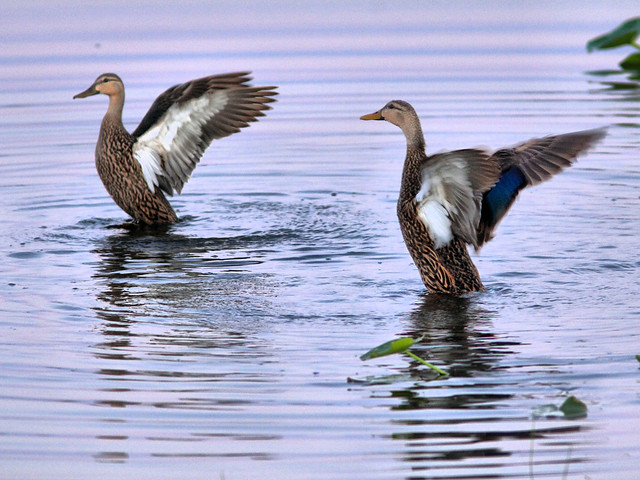
Sightings of the mammalian kind included these White-tailed Deer. The buck's antlers were in very early velvet stage, and one of the does appeared to be pregnant:

I got quite a fright very early one morning as I nosed through some brush to get a photo of the wet prairie. Suddenly I saw a large black creature not too far away. It was too dark for me to photograph or even make out its shape so I watched for a while as it moved slowly along the edge of the high grass.
Then I remembered that decreasing the exposure compensation permitted the camera to focus better in the dark. The prolonged exposure time also caused a blurred photo as I was not using a tripod, but it was good enough for me to recognize the creature as a large wild pig-- the first I have seen here over the ten years I have been walking the patch [This photo was taken a few minutes later, at Exposure Compensation Minus 1, ISO 3200 at 1/25 second]:
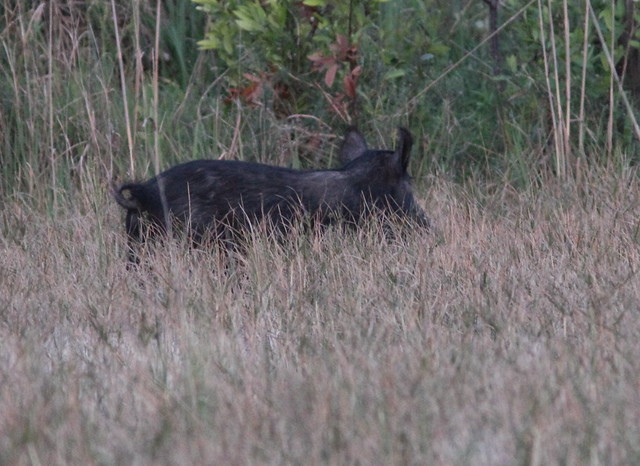
Looking for a fence picture for Tex's Good Fences meme, I found this one, of the lighthouse on the point at Sanibel Island on the Florida Gulf Coast. This was taken just after Easter, when we spent a few delightful days there with our Illinois granddaughters and family. It is processed as an antique oil painting:
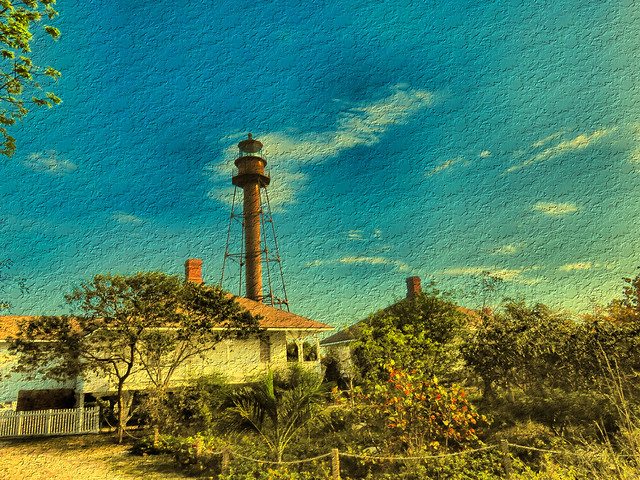
GOOD NEWS! IMPORTANT UPDATE to my April 14 post "Bald Eagles hatch second brood-- BUT..."
Remarkably, one observer provided a photo of two eaglets on the nest five days after another photographer witnessed (on April 11) what she interpreted as the smaller/younger of the two being killed. She saw and documented a struggle between both siblings. Her photo clearly showed what appeared to be the lifeless form of the smaller one sprawled over the rim of the nest. Here is a link to her photo:
The subsequent observer wrote: "At 09:15 today [April 16] I saw and photographed both eaglets. They were both alive, and moving throughout the nest and doing well. Mom was also in the nest..." His photo showing the two may be viewed here at this link.
At first I wondered whether the "dead" eaglet may have been a third and even younger nestling, but what I now think that this represented a defensive instinct which protected the weaker sibling from further attack.
I have seen this kind of behavior in small birds when a hawk suddenly appears. Usually the birds scatter into protective shrubbery and remain perfectly still. If surprised out in the open they may "freeze" in place as long as the threat is present.
As a kid I often helped my grandfather catch chickens which roamed in our adjacent backyards. If I cornered one by extending my hands in front of it (almost like a hawk swooping down) it would suddenly become motionless, crouching low. I could pick it up and even turn it on its back without it trying to escape. See "How to Hypnotize a Chicken" in the The Old Farmer's Almanac at this LINK.
= = = = = = = = = = = = = = =
Linking to Misty's CAMERA CRITTERS,
Linking to Eileen's SATURDAY'S CRITTERS,
Linking to GOOD FENCES by Tex (Theresa).
Linking to WEEKEND REFLECTIONS by James
Linking to BirdD'Pot by Anni
Linking to Wild Bird Wednesday by Stewart
________________________________________________
Please visit the links to all these memes to see some excellent photos on display
________________________________________________
Hello, good news on the eaglets. So many gorgeous birds and photos. Some of my favorites are the Green heron and the Stilts. What a lovely post. Have a happy day and weekend ahead!
ReplyDeleteAs usual stunning photos, and these give some idea too of the progress of the seasons.
ReplyDeletevery much enjoyed your post. I need to get a summer home in northern climes. My body is disliking our Tampa summers evermore each year. And our spring seems to be short this summer. Returning home from walks already with a soaked shirt. Ack. Too soon. Too soon.
ReplyDeletea great lighthouse photo! glad the eaglets are both intact! and hopefully will remain so...
ReplyDeletebeautiful watery shots and reflections. just wonderful!
More amazing pictures! I love the ones of the Stilts at sunrise! And an interesting sequence of waterlevels too.
ReplyDeleteWow, Kenneth, you have outdone yourself! Absolutely stunning photos! Thank you so much for sharing your amazing talent, I always look forward to your posts. :)
ReplyDeleteWow! All very creative wildlife photos ~ love the deer and gorgeous birds and settings ~
ReplyDeleteHappy Weekend to you ~ ^_^
Stunning display of so many interesting sights. Truly enjoyable.
ReplyDeleteA fabulous series of photos! Thank you for sharing your talents with us.
ReplyDeleteAlways a pleasure to stop in. The deer were so pretty. All the birds are great, I especially like those "Stilts" - Such long legs!
ReplyDeleteLovely areas you have to view wild life & fences. Awesome news about the eaglets.
You have so many very artistic photos. I really like your photos! The Black-and-white Warbler is great.
ReplyDeleteSTUNNINGimages as usual and the reflections in the water withthe birds are amazing. grea that the Green Heron had so many chicks. Hope you have a wonderful weekend.
ReplyDeleteSo many beautiful reflections of the birds.
ReplyDeleteamazing photos...it is great that you were able to see the heron eggs hatching!!
ReplyDeleteHello Ken. I just wanted to stop back and say thank you for linking up and sharing your post. Happy Saturday, enjoy your weekend!
ReplyDeleteYour photos are wonderful as usual. :-)
ReplyDeletestilts are happy birds aren't they
ReplyDeleteSebring, Fl
Hello Ken!:)Loved every photo, and so many different nature shots to enjoy,and learn from. Gems all of them!:)
ReplyDeleteInteresting post and stunning photos!
ReplyDeleteA wonderful series of photos!
ReplyDeleteI don't remember seeing the Stilts before - very pretty!
We have wild hogs here - dangerous animals
Glad your eagles are okay. The ones we watch at Shiloh, TN, did not nest this year. Don't know why.
Lea
Beautiful photos! The stilts are lovely and the baby herons so precious.
ReplyDelete